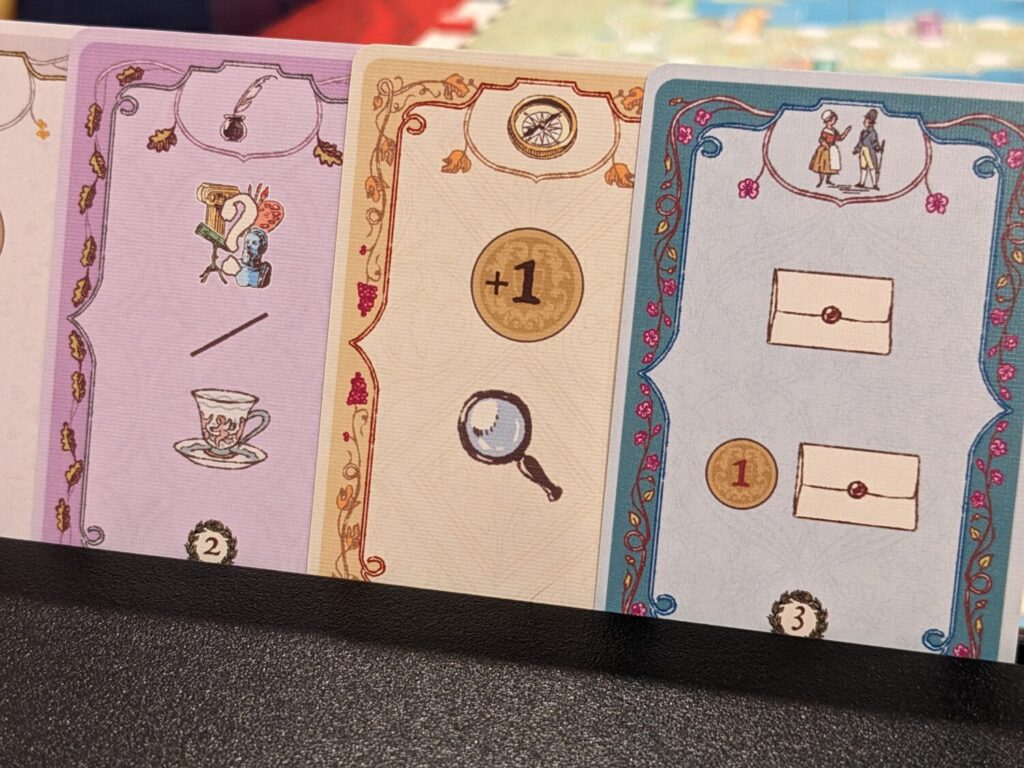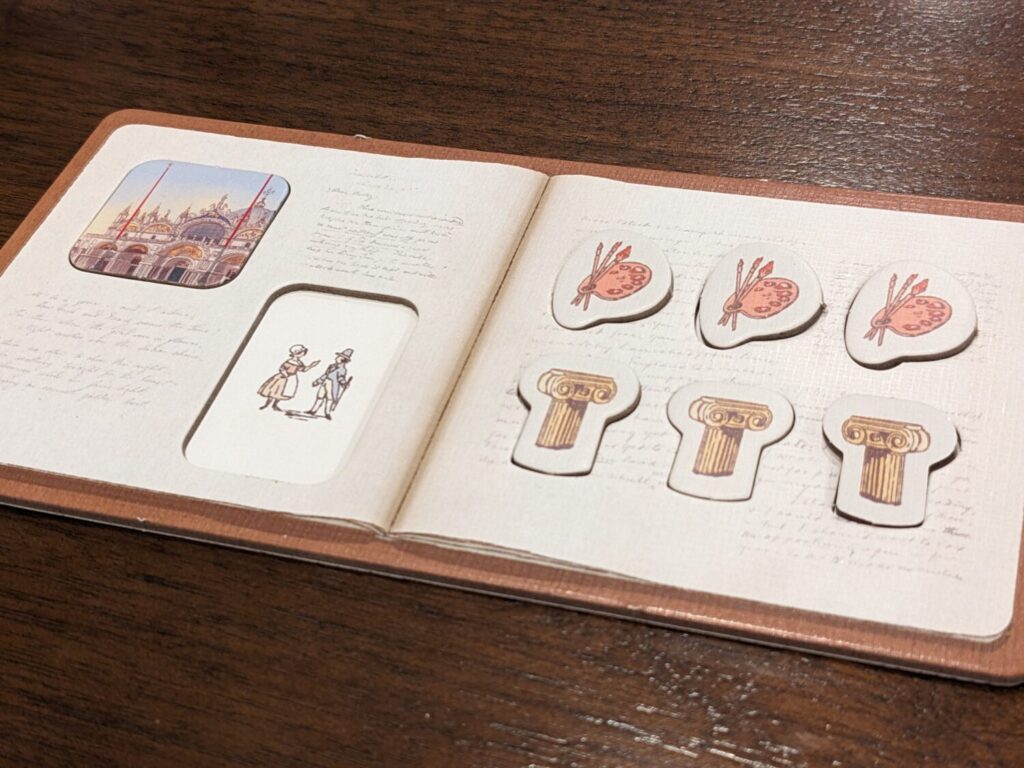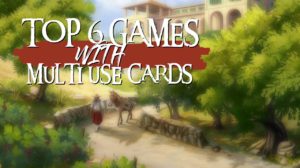Disclosure: Meeple Mountain received a free copy of this product in exchange for an honest, unbiased review. This review is not intended to be an endorsement.
The design duo of Fabio Lopiano and Nestore Mangone—the twosome that gave us last year’s Shackleton Base: A Journey to the Moon, amongst other greats—has forced me to chase every game one or both designers is a part of in 2025, for better and for worse. Lopiano’s hands were all over the stellar Ayar: Children of the Sun, and when I learned that Mangone had partnered with Andrea Robbiani to design a new game called Timeless Journeys: The Italian Grand Tour (2026, Lirius Games), I needed to know if Mangone’s magic would surface again.
I tried and failed to join a convention play of Timeless Journeys at Gen Con 2025, as I mismanaged my schedule. Luckily, the team at Lirius was open to sending me a prototype to try out in advance of the game’s ongoing crowdfunding campaign. After sending a copy of the prototype rules, I dove in and got the game to the table for a couple of plays.
My first pass of the rules didn’t give me a great feeling, but I have sometimes been wrong when trying to guess how a game will really play based purely on the rulebook. So, I did a two-player game with my wife then did a three-player game with two different players. (I was hoping to do a solo play, but the solo bot rules and components were not included with the prototype.)
Friends, it brings me great pains to say that in its current state, Timeless Journeys is only average fare. Some of this is on me—the expectations for a Mangone title have jumped the shark in my networks. For others, I wonder if they will think this is a stroll worth taking.

Let’s Take a Walk
Timeless Journeys: The Italian Grand Tour is a hand management, deck-building game for 1-5 players that plays in about 20-25 minutes per player. It is approximately the 18th century—the rulebook keeps this a bit vague—and players take on the role of tourists who must navigate the Italian countryside and visit as many as eight different cities in search of friendship, exploration, and interesting discussions on the ideas of the era, all while trying to meet up with famous travelers like Mary Shelley, John Keats, and Charles Dickens along the way.
On paper, the ambitions here sounded fun. Write in your travel journal! Meet famous people! Debate the ideas around art and culture while in a café! My wife, in particular, was drawn to the theme…at least, until the game revealed itself, as players take five turns per round to play cards and move around the map to pick up different tokens to either deliver to city locations or add to one of the two journal booklets each player has to begin the game. Timeless Journeys turns into a set collection game, as players try to earn dozens of points by writing things down in their journal, a mechanic that essentially adds a token to the journal from a player’s collection.
Each player has a hand of cards, with each card coming in one of four different suited colors (white, blue, purple, orange). On a turn, a player places one card on the table and executes the action, basic stuff like moving around the map, getting idea tokens, having a conversation with a local in the current city (usually to get a one-time bonus), etc.

On successive turns, if a player plays a card matching the color of any cards played earlier in the round, they trigger all of those cards again. That can lead to some big turns. If a player has just played an orange card, in a round where they already played two other orange cards, all three orange cards trigger. Those moments are what make Timeless Journeys shine, and we found that these moments led to some very combo-rich turns if a player set themselves up.
The main reason why a player wouldn’t do that? At the end of each round, all players get to draft one new card to add to their hand, but the best cards can only be acquired this way if a player played cards in different colors during that round. If four of a player’s five cards (or more) were different colors, they can choose from any of the three market rows to build their deck. Getting other cards can also be done during the round, if a player uses their turn to play any card from hand face-down, allowing them a chance to buy a card for 0-5 coins.
So, the card play here is interesting; it never blew anyone’s mind but finding ways to build a deck around just 1-2 colors led to very cool combinations. The cards are suited in a way that ties to their actions; orange cards are usually movement and exploration cards, while white cards are wild and feature all of the game’s different actions. (Yes, for this reason, even after just two games, I found myself always hunting for white cards…hint, hint.)
More troubling were two main areas—the actions that were avoided during my games, and the power of the Famous Travelers. Some of the powers feel just a tad overpowered for my liking, albeit at the prototype stage in a game that I believe will tweak its ruleset prior to release.

You’re Going to Want to Meet the Famous People
I love the idea that I need to rush to certain spots on the board at just the right time to meet up with one of each game’s three Famous Travelers. That puts a bullseye on certain locations each round to become the player that could earn a small one-time bonus and possibly a second ongoing bonus to boot.
Here’s how it works. At the beginning of the game, three Famous Travelers are drawn (randomly, by choice, or using a guide in the game’s rulebook) and placed in three different columns of a small Gazette board. This also shows the location of where each Traveler will be in each game round. When players visit the location of a Traveler and use the Have a Conversation action, they can place one of their Experience tokens on the space next to the Traveler, permanently blocking it.
Once claimed, players then have access to either an ongoing action or an end-of-round scoring opportunity. (One of the Travelers has a massive end-game scoring mechanic, which we’ll come back to.) As written, the rules indicate that a player who has met a Famous Traveler has access to that Traveler’s power for the rest of that round.
I used that in my second game when I met the German poet Goethe; his power grants the player up to seven victory points based on the number of coins they have at the end of each round. Another player used the benefit of the French painter Élisabeth Visée Le Brun to collect painting tiles each time the player took the Explore action in the city where the Le Brun marker was in a particular round.
Some of the scoring boosts are massive for the Famous Travelers, and depending on turn order and the foresight of a player, there already appear to be ways in which savvy players will do a better job of manipulating the Travelers than others. That, mixed with players who figure out ways to add tokens to their personal journey boards faster than others, might lead to a runaway leader problem.
My other main issue in Timeless Journeys was the “Discuss in the Café” action. (The action names are…not great.) In each city, a player can use their pile of previously-collected idea tokens to burn them for points. Because these are the same tokens used to build up the personal journal boards, it feels like Timeless Journeys is steering players towards a choice: burn the tokens in the local café, or do the journal.
It is significantly easier to spend the tokens as a part of the café action—it only takes one action to spend as many tokens as are needed to satisfy a café’s delivery condition, but it takes one action PER TOKEN to add those tokens to the journal. Even after my first game, I realized how much more efficient it might be to spend the tokens in a café…but the pick-up-and-deliver nature of the café action is just less interesting, never mind that it doesn’t feel like I’m really having a debate in the late 1800s at a local café by handing in five matching science tokens.

Let’s Hold For Now
Timeless Journeys: The Italian Grand Tour is…okay.
Managing the hand of cards is interesting and finding ways to take combo-rich turns is always a turn-on, at least for me and the Euro-centric gamers in my strategy circles. Timeless Journeys had a couple moments each game where I felt like a genius, as I found ways to navigate large stretches of the map to get coins, exploration tiles, and idea tokens to string up big turns.
The advanced action cards (basically, every card that is not a starting hand card) are also worth victory points, with a number of cards featuring scoring conditions that can help build a nice strategy around the cards. Because a player can only have eight cards at the end of each round, building a deck that has eight high-value scoring cards ends up being an important consideration when selecting cards.
But the overall experience feels a bit empty, especially in the first round or two. During those early stages, players will spend their entire round moving to maybe one new city, taking a tile, spending their last coin, and doing other things that merely set up future rounds.
The way card actions work, we found that the first player in the first round always had the best chance to meet the Famous Traveler in the city one space away from the starting location of Turin. That bonus might be crucial, and because there is additional area majority scoring for each Famous Traveler, that gives one player an edge that might be a little too overpowered.
The map’s routing works the same every game, so you can always expect to work your way from north to south every time. Having a central starting location and shaking up the movement patterns of the Famous Travelers might lead to an experience with more variety.
As one player noted, Timeless Journeys is fine but it never featured any true “wow” moments. Timeless Journeys is not on the level as Mangone’s recent output; Autobahn, Shackleton Base, and Darwin’s Journey are all games that offer more interesting decisions than anything on display in Timeless Journeys, albeit with significantly more complex rules sets.
I’m a Mangone superfan, so if you are like me, consider a purchase if you are a completionist or if you are a lover of a good hand management system. Otherwise, I recommend looking at other Mangone titles to get a better flavor of the artist.











